What should the coolant be for heating systems: fluid parameters for radiators
Despite the promotion of alternative methods of heating rooms, in the vast majority of cases the main heat source is a liquid heating circuit.Due to its economy and efficiency, it is optimal in the long winters typical of our latitudes.
The downside is that the water can freeze. Therefore, in addition to it, a non-freezing coolant is also used for heating systems, replacing water. In this article, we will take a closer look at its main varieties, consider their significant advantages and main disadvantages.
We will also provide an algorithm for calculating the required volume of coolant for a specific system and recommendations for choosing the type of fluid for heating circuits.
The content of the article:
List of coolant requirements
The main task of the liquid in the pipes is to transfer thermal energy from the boiler to the radiators.
For a heating system to be safe and energy efficient, the coolant must meet a number of important requirements, including:
- preservation of pipes from corrosion;
- chemical inertness to seals installed in the pipeline;
- operating temperature range suitable for the pipes’ operational parameters (from freezing to boiling);
- high heat capacity to accumulate as much heat as possible;
- minimal ability to form scale;
- complete safety: no release of toxic fumes and maximum explosion and fire resistance;
- stable chemical composition - the liquid should not decompose and change its physical properties when exposed to high temperatures.
And now the main question: which antifreeze for modern heating systems meets all the requirements?
The answer may be disappointing, but no such liquid exists in nature today. Such an ideal chemical composition has not yet been created. Therefore, the question of selecting the optimal option is a very pressing task today.
When is antifreeze necessary?
Before you start considering alternative liquids, don't discount water. If heating is installed in a house where residents live permanently, then water will be one of the safest and most reliable options.
As a coolant, it has optimal parameters for circulation through the circuits of heating systems.
However, at the peak of winter frosts, the slightest crystallization of water can cause a serious accident with the destruction of the pipeline and heating equipment components.
If we are talking about a country house, which is periodically visited, or when on weekends the family often leaves their abode, leaving the heating unattended, then the coolant used must be resistant to the low temperature range characteristic of the area.
Only for the use of chemical compounds as a carrier of thermal energy, it is necessary to prepare the heating circuits. The system must be completely sealed, because the liquid is toxic and flammable to varying degrees.
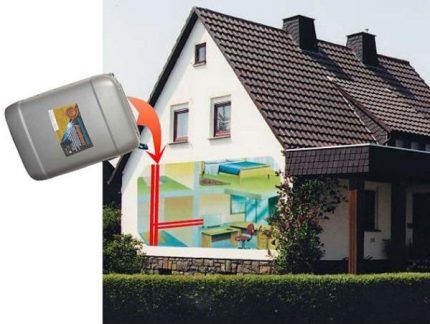
The owner must take into account that the antifreeze liquid needs to be changed periodically, which is fraught with additional costs.
Some models of boiler equipment have specific recommendations for the use of a certain brand of coolant. If you use a liquid of a different composition, you may lose the warranty on the boiler.
Review of popular coolants
To protect yourself, we’ll take a closer look at each type of coolant.
Option #1 - water with additives
70% of modern systems use water, including its modified compositions using additives.
What explains this popularity:
- complete harmlessness — a leak can only cause domestic difficulties;
- highest heat capacity – about 1 cal/g*C (each liter of water is capable of transferring more heat than any other liquid);
- cheap and accessible - water has a minimal cost compared to non-freezing compounds. The water system can be replenished at any time without significant investment of time, labor and money.
True, it is undesirable to replace water in the heating circuit without a good reason. When heated, it is freed from salts and oxygen.
Water that has boiled several times in the boiler no longer has the same composition and amount of salts as it had when it was poured into the system. Unlike the new portion, it is practically devoid of free oxygen.
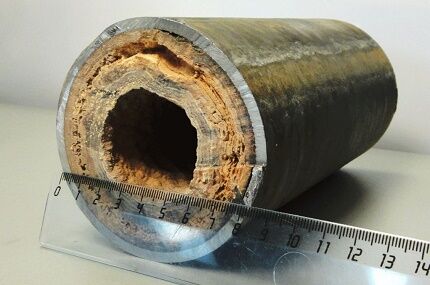
The other side of the coin is this:
- Relatively high freezing point, so leave unattended water heating system it is impossible (otherwise, when water freezes and expands, it can rupture pipes and radiators);
- The salts contained in the composition can provoke deposits on pipes and heating elements, which reduces heat generation and the overall efficiency of the system;
- Water is an oxidizing agent, and oxygen dissolved in it can cause corrosion of metal heating elements, including radiators.
Nothing can be done about the freezing temperature, but other negative properties can be significantly reduced. To begin with, you can reduce the salt concentration using softening. You can reduce the amount of hydrocarbonate salts by boiling.
Sodium orthophosphate, which can be purchased at the store, softens water. In this case, you need to remember about the correct dosage, because... excess reagents can negatively affect the thermal properties of water.
To avoid confusion with dosages, you can use distilled water, but it will cost an order of magnitude more. Now you don’t have to worry about the radiators becoming clogged with scale. To cheat and save money, you can use melt or rain water.
It is already naturally distilled. But its purity can only be partial. It could well be saturated with atmospheric pollution, but in any case it will be much softer than water from wells, wells or taps.

Manufacturers offer distilled water enriched with inhibitor additives. They significantly reduce the likelihood of corrosion.
Also, surfactants (surfactants) are introduced into such a distillate. Their content in water minimizes the formation of deposits on the internal surfaces of radiators.
The surfactant causes existing deposits to peel off (with their subsequent removal from the system using a filter), and also reduces the chemical activity of water. As a result, all gaskets and seals will last longer.
Option #2 - non-freezing antifreeze
Even distilled water with the optimal set of additives is not without its main drawback - freezing at 0 degrees Celsius. A special liquid for metal heating radiators is free of this flaw, and in addition has a lower crystallization temperature.
Low temperatures affect antifreeze differently than water. Even when the minimum operating values are exceeded, the liquid does not crystallize or expand, but turns into a gel-like substance. Therefore, pipes and radiators are protected from deformation and damage.
As the temperature rises, the consistency of thickened antifreeze becomes more liquid, and fluidity rates increase, although in normal condition they are 15% lower than those of its traditional rival - water.

The concentrated antifreeze composition can be diluted according to the manufacturer's instructions, taking into account local climatic conditions. To obtain a liquid with a freezing limit of -30°, dilute it with water by half; for -20°, part of the antifreeze is mixed with two parts of water.
Most compounds can withstand up to -65 degrees. In most areas of the north and middle zone, the temperature rarely drops below -35, so antifreeze is often diluted with distilled water, lowering the threshold to -40.
Manufacturers of high-quality solutions make the composition as stable as possible, so it can last up to 5 years. After this, it will need to be completely replaced.
To achieve these properties, we had to sacrifice some of the benefits that water has:
- the heat transfer of antifreeze is 15% lower, sometimes this may entail the need installation of additional radiators or sections;
- may contain toxic substances, so antifreeze cannot be used in 2-circuit systems where the composition may enter the hot water supply circuit;
- high fluidity compared to water, due to which it is necessary to use specific seals that can prevent leaks;
- increased viscosity, which will require the use of a more powerful pump - recommendations for choosing a pump and a review of the top ten models we reviewed here;
- a higher expansion coefficient will require the installation of an expansion tank of increased volume.
When using all types of antifreeze, heating installations cannot be carried out with galvanized pipes, because in contact with them, the antifreeze loses some of its original beneficial properties.
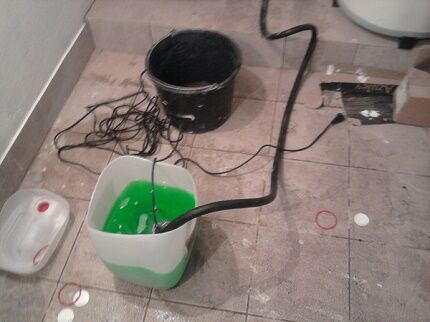
The use of non-freezing liquids as coolants forces changes to be made to the heating system design. Due to the viscosity of antifreeze, it transfers heat to heating devices more slowly, so it is better to increase the number of radiator sections or purchase devices with a higher heat capacity.
It is also necessary to reduce friction in pipelines by replacing fittings with analogues one position larger than those used in water circuits.
Modern antifreeze liquids, depending on their composition, can be divided into three main types:
- glycerin;
- based on propylene glycol;
- based on ethylene glycol.
Let's consider each separately to choose the most suitable option for existing equipment and conditions.
Option #3 - ethylene glycol-based anti-freeze
One of the most popular antifreezes takes its place of honor on store shelves thanks to the most affordable price due to its simple production process.
The liquid contains about 4% additives that prevent ethylene glycol from foaming at high temperatures. This also includes inhibitors that prevent corrosion from attacking metal surfaces.
Due to the aggressiveness of ethylene glycol, the product is used only in diluted form to protect the inside of pipes and radiators.
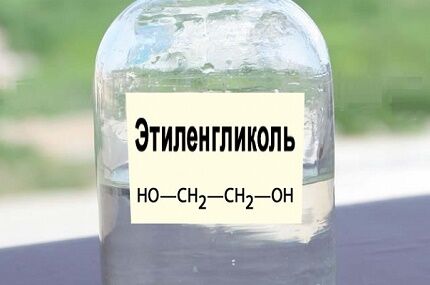
The main disadvantage of ethylene glycol is its toxicity. A minimal amount of this substance in the human body can cause serious health problems. Therefore, the entire heating system must have the highest degree of sealing.
Another gap in the use of ethylene glycol is the constant control of temperatures. If the boiler heats the liquid to a temperature close to the boiling point, the composition will begin to decompose with the formation of solid sediment and the release of acids, which has a destructive effect on all heating equipment.
The specified antifreeze is suitable only for those systems where it is possible to accurately maintain the temperature, but not all boiler equipment is equipped with such a capability.
Option #4 - propylene glycol-based liquid
This is a more modern antifreeze that has gotten rid of some of the disadvantages of ethylene glycol.
Advantages:
- non-toxic - the composition contains additives that are used in the food industry;
- can be used in dual-circuit systems, because even an accidental mixture into the drinking circuit will not harm human health;
- higher thermal properties;
- operated for 10 years;
- act in the heating circuit according to the principle of lubrication, which reduces the hydraulic resistance in the pipeline and increases the efficiency of the system.
But one drawback could not be eliminated - incompatibility with zinc. Special additives lose quality when flowing through galvanized pipes. Another relative disadvantage is the twice as high price.
Option #5 - glycerin antifreeze
Glycerin antifreeze is equated with water, as close to an ideal set of properties, but at the same time is criticized. Opinions differ, so it makes sense to voice all the points.
Proponents of the glycerin composition identify the following advantages:
- environmentally friendly and safe solution;
- wide operating temperature range - -30+100;
- when freezing, it expands to its minimum values;
- not aggressive to galvanized pipes and radiators;
- costs less than propylene glycol;
- service life 7-10 years.
The glycerin-based version is non-explosive and non-flammable. A significant plus is that it practically does not destroy the seals.

Among those who are against this coolant, there are the following arguments:
- large mass, which causes additional load on the pipes;
- lack of quality standards for glycerin mixtures;
- when overheated and water evaporates, it loses its properties, turning into a gel-like mass with hardening;
- increased foaming;
- at temperatures above 90 degrees it may begin to decompose;
- lower heat capacity compared to propylene glycol;
- due to increased viscosity, it contributes to faster wear of equipment.
It is worth noting that in some countries where ethylene glycol is banned, there is no production of glycerin coolants at all. Due to the contradictions in the use of glycerin liquid, responsibility for its use falls entirely on the owner.

Option #6 - coolant for an electrode boiler
This type of equipment must be noted separately, because Electrode boilers require a special type of coolant. In this case, the liquid is heated due to ionization from the influence of alternating current.
Antifreeze must have a certain chemical composition that can provide three conditions: the correct values of electrical resistance, electrical conductivity and ionization.
Manufacturers of electrode boilers give their own strict recommendations on the use of specific brands of coolant. Therefore, you need to select antifreeze with special care so as not to lose the warranty.
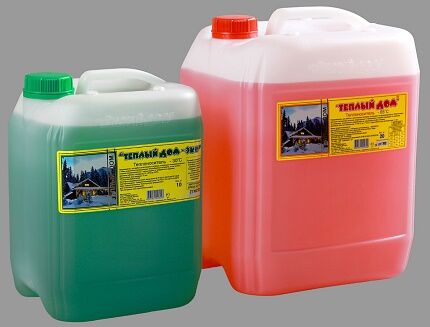
Recommendations for choosing a product
It is necessary to take into account not only the characteristics of the coolant for the heating system, but also the configuration of the equipment in order to make heating safe and efficient.
If you decide to use antifreeze, let's look at the conditions under which its use is excluded:
- lack of a heating temperature regulator in the boiler;
- when using oil-treated flax seals;
- the heating circuit uses pipes, radiators, shut-off valves with a galvanized surface;
- open type heating system
Evaporation of water from an antifreeze liquid can change properties, and ethylene glycol vapor is toxic.
Compliance with the following rules will allow owners to get rid of a number of troubles due to incorrect use of antifreeze liquids:
- in places of sealing, flax tow must be coated with sealing paste;
- sectional radiators need to be sorted out to replace the seal with Teflon or paronite gaskets;
- do not use automatic air vents (to bleed off excess air, it is better to install Mayevsky cranes for manual adjustment);
- radiators and pipes must have increased volume and diameter;
- the presence of a high-power circulation pump;
- install membrane expansion tank with increased volume.
Antifreeze is poured into the heating system only after quality flushing the heating circuit, for which it is better to use special compounds. For the safety of all residents, experts recommend using propylene glycol.
The boiler cannot be immediately after filling the system with coolant bring to peak power. It is necessary to increase the temperature in steps. This is necessary for the antifreeze to gain optimal performance characteristics and expand within normal limits.
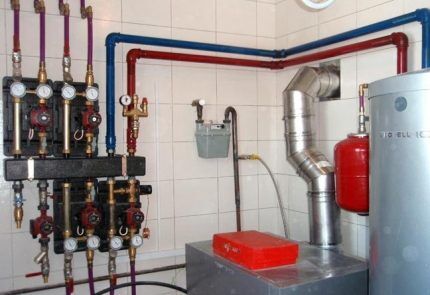
When diluting a liquid with water, concentrations should not be allowed higher than -20 degrees. Excess water will cause scale deposits and change the performance properties of the glycol. Can only be diluted with distilled water.
How to determine the volume of coolant?
The easiest way is to use a water meter or water flow meter. There is one in almost every house or apartment with a centralized water supply.
Before starting measurements, the heating circuit must be completely emptied. Then readings are taken on the meter, and the system begins to be filled with a small pressure of water. This is necessary to avoid air pockets that distort the readings.
As soon as the heating pipeline is filled with water, you need to take the water meter readings again. You need to remember that 1 cubic meter is 1000 liters, and purchase the appropriate amount of liquid.
The second method is less convenient, but effective when there is no counter. The filled system is emptied through a measuring container (tank or bucket of a certain volume). The main thing is not to go astray with the number of buckets.
Another method is mathematical. The values of the volumes of radiators and expansion tank, pipe diameters, and the volume of the boiler heat exchanger are taken as initial data. Using simple geometric and arithmetic formulas, you can calculate the final volume.
We looked at detailed examples of calculating each of the elements of the heating system in our following articles:
- Calculation of pipe volume: principles of calculations and rules for making calculations in liters and cubic meters
- Expansion tank for open type heating: device, purpose, main types + tips for calculating the tank
Conclusions and useful video on the topic
The video will introduce a specialist’s opinion on whether it is worth changing the water to an antifreeze liquid:
A detailed analysis of the features of filling the heating system with coolant and recommendations for correctly starting the system in the following video:
The given facts reveal a complete information picture for each owner, who is determined by the choice of coolant. He will know what liquid he needs, what conditions are necessary for its use and how to create them.
What kind of liquid circulates in your heating system? Why did you choose this particular coolant and are you satisfied with its operation? Share your opinion in the comments block.
Or are you just deciding on the type of coolant, but did not find answers to your questions in this article? Ask your questions in the comments - we will try to help you.




When we installed radiators in a new house that we had just built, we used glycerin-based liquid as a coolant because it does not destroy seals and is completely safe to use. Because glycerin is not explosive, and it is also not aggressive to radiators. And most importantly, this is a very cheap and economical means to solve this problem.
When we were renovating our apartment, we also wondered what liquid to use. I searched for information for a long time and asked friends. Initially, I thought not to steam and fill it with regular water, but still turned to professionals for advice. They suggested that for our climate it is still recommended to use antifreeze, so that’s what I did. In general, there is nothing to complain about, perhaps the only problem is the need to replace antifreeze every 3-5 years (depending on the quality), no other shortcomings were noticed.
Is it possible to use car antifreeze/antifreeze/antifreeze in the heating system?
If you carefully read the article, the material makes a separate point that antifreeze cannot be used in its pure form in the heating system! Since this can lead to accelerated corrosion. Accordingly, it is necessary to choose the right concentration that will protect the heating system from freezing and will not harm it during operation.
Antifreeze should be added only after thoroughly flushing the heating circuit; for this purpose it is best to use propylene glycol, which poses virtually no health hazard.
The best option would be a solution in the form of glycerin-based antifreeze. The liquid does not burn and is not explosive, and its undeniable advantage is that it does not destroy seals. Glycerin-based antifreeze has low corrosive activity. Regarding antifreeze and antifreeze, I can’t give any advice.
A useful article, based on it, Thermagent -30 ECO antifreeze was poured into the system, containing propylene glycol and organic additives.